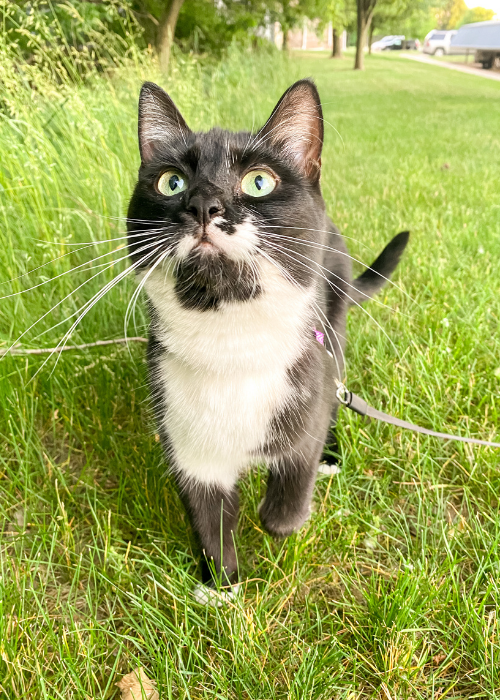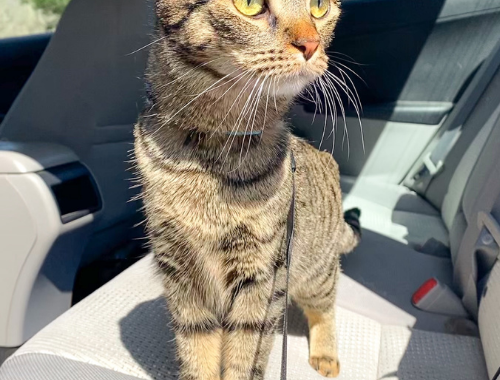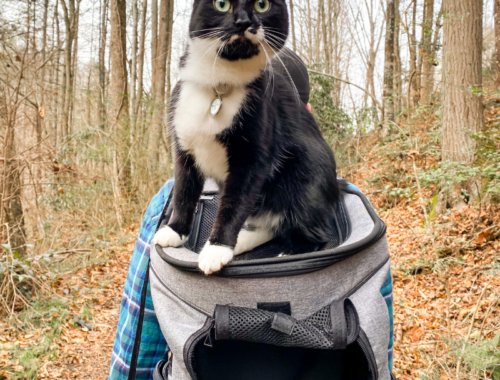
Best Tips For Building Trust With Your Cat
Trust is the foundation for all relationships, people and pets. But building trust with your cat can be difficult, since you do not have a direct way to communicate. There are many ways to learn to talk to your cat and get them to trust you. And with adventure cats, building trust is vital in order to make their outdoor experiences positive. We recommend you do not take your cat outside until they trust you because if they get scared outside, you want to make sure you know they will come to you for safety.
Learning To Communicate With Your Cat
Finding a way to communicate with your cat is key for their successful outdoor training. Cats do not understand when we ask them to do something. You need to work on learning how your cat communicates in order to be effective. There are tools, such as clicker training, which has shown to be a very effective training method for cats. This can also aid in building trust and strengthening your bond with your cat. And clicker training can be used to harness and backpack train too, so it’s a win/win for everyone! Check out our article on clicker training here!
Building Trust Inside First
Building trust starts inside, and ideally before even taking your cat outside. Setting the groundwork inside can really help the transition to outdoor adventures. It is important to keep in mind that when outside, there is a lot more stimulation, and your cat can get overwhelmed. Do not be surprised if your cat doesn’t let you do some things that they do when you’re inside. When you go outside, you want to go slow and start with baby steps to get them comfortable being outside with you.
Give them time to adjust
This is for both inside and outside. When you first bring your cat home, allow them to explore and come to you on their own terms. Allowing your cat to get used to things at their own pace is a great way to give them a sense of security. And this not only goes for getting used to their new environment, but getting used to you as a person too!
When going outside, this same principle applies. Give your cat time to adjust to the environment. Even if you have been to that place before, there may be different sounds or smells this time and your cat needs some time. This can be done by either by carrying them in their backpack for the first 5-15 minutes before letting them out or sitting in one spot and letting them come out of their backpack on their own.
Tips For Building Trust
Handling
Handling your cat and getting them used to be touched is a good way to help build trust, but also assess their trust in you. You want your cat to be comfortable with being held and touching their face, paws, mouth, and belly. Those are vulnerable areas to cats, and if they let you pet them there, that is a sign of trust.
Be patient
Trust takes time. It requires you showing your cat that they can trust you in every situation. Your cat needs to know that they are safe with you and if something unexpected happens outside, that you will protect them. But this does not happen overnight. You need to prove to your cat, over and over again, through your actions, that they can trust you. Depending on the cat, this can take anywhere from days to weeks to months to even years. Patience is key. Never rush your cat to trust you prematurely, as that can actually cause them to not trust you!
Respect your cat’s boundaries
It is important to understand and read your cat’s body language, because that will tell you if they are comfortable or not. Pushing your cat out of their comfort soon too much too fast can really set back their training. You want to be in sync with your cat and make sure that they feel safe. Some sort of boundary pushing is healthy, as you want to expose your cat to new things. But there is a point where it does because too much. You want to be sure you have back-up plans and safety precautions in place.
For example, if you are taking your cat kayaking for the first time. This new experience can be a lot for them. So, prepare to help them feel safe. Leave them in the backpack during loading and then open it and let them come out on their own. Bring treats for positive reinforcement. And stay close to shore in case you need to get them off the kayak quickly.
Remember that all cat’s are individuals too. Some cats can handle more than others. Some take shorter time to get used to things. It’s all different, but you know your cat best. Know how they communicate, respect them, and keep them safe!
Positive reinforcement
One of the most effective ways to train pets in general is with positive reinforcement. You want to reward the good behavior, rather than punish/unwanted them for bad behavior. The reward can be anything that your cat values, such as a treat, pets/cuddles, attention, verbal praise, or play time. Every cat likes different things, so try these out and see what your cat responds best too. Positive reinforcement teaches your cat that they get rewarded every time they do a specific action. This makes them want to continue to do this. For example, every time you call their name outside, they get pets and praise or even a treat when they get to you. This makes your cat want to come every time they are called, as they get something good out of it too.
Protect your cat
Trust is earned, not given. Show your cat that they can trust you to protect them in situations they are not comfortable in. When you take your cat outside, you will see what makes them uncomfortable, based on their body language. For example, maybe your cat is scared of people walking passed you, dogs, bicycles, or something else. If you see any of those things while out walking your cat, then you can prepare and get your cat out of harm’s way. Things like putting them in their backpack while the threat passes, sitting down on the ground with them and reassuring them, or standing between the threat and your cat to block them are different ways you can protect them. Your cat will learn that when they are scared, you will protect them, which in turn, earns you their trust.
Conclusion
Building trust is not only great for bonding, but important for safety and protection of your cat. It is a vital step in adventure cat training that should never be skipped. Your cat will have more confidence when outside when they know they can trust you in any situation. But this trust goes both ways. In a case where your cat may escape it’s harness, you want to be able to trust that your cat will come back to you. When they think of you as their safe spot, they will run to you, or come back to you, for their safety.
We were on the Catventurous Podcast and talked a lot of trust and other adventure cat things! Check it out here if you want to listen to it!.
You May Also Like

How To Start Clicker Training With Your Cat
January 22, 2021
The Ultimate Checklist For Traveling With A Cat
July 30, 2021


